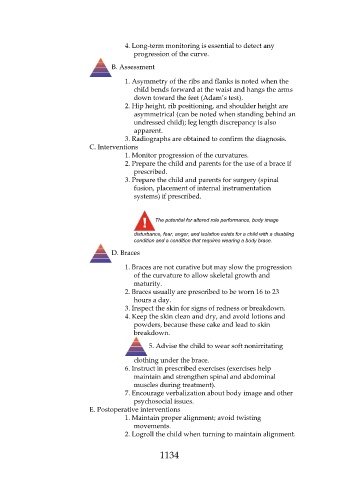Page 1134 - Saunders Comprehensive Review For NCLEX-RN
P. 1134
4. Long-term monitoring is essential to detect any
progression of the curve.
B. Assessment
1. Asymmetry of the ribs and flanks is noted when the
child bends forward at the waist and hangs the arms
down toward the feet (Adam’s test).
2. Hip height, rib positioning, and shoulder height are
asymmetrical (can be noted when standing behind an
undressed child); leg length discrepancy is also
apparent.
3. Radiographs are obtained to confirm the diagnosis.
C. Interventions
1. Monitor progression of the curvatures.
2. Prepare the child and parents for the use of a brace if
prescribed.
3. Prepare the child and parents for surgery (spinal
fusion, placement of internal instrumentation
systems) if prescribed.
The potential for altered role performance, body image
disturbance, fear, anger, and isolation exists for a child with a disabling
condition and a condition that requires wearing a body brace.
D. Braces
1. Braces are not curative but may slow the progression
of the curvature to allow skeletal growth and
maturity.
2. Braces usually are prescribed to be worn 16 to 23
hours a day.
3. Inspect the skin for signs of redness or breakdown.
4. Keep the skin clean and dry, and avoid lotions and
powders, because these cake and lead to skin
breakdown.
5. Advise the child to wear soft nonirritating
clothing under the brace.
6. Instruct in prescribed exercises (exercises help
maintain and strengthen spinal and abdominal
muscles during treatment).
7. Encourage verbalization about body image and other
psychosocial issues.
E. Postoperative interventions
1. Maintain proper alignment; avoid twisting
movements.
2. Logroll the child when turning to maintain alignment.
1134

